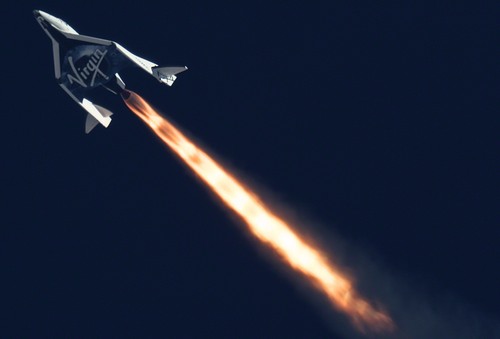
SpaceShipTwo flies on its second powered test flight on September 5. (credit: MarsScientific.com and Clay Center Observatory)
SpaceShipTwo did indeed take to the skies on Thursday, performing its second powered flight and the first since late April. SpaceShipTwo fired its hybrid rocket motor for 20 seconds after being released from its WhiteKnightTwo carrier aircraft, reaching a peak altitude of 21,000 meters (69,000 feet) and a top speed of March 1.43, according to a company release. That’s just a little bit more than that April 29 inaugural powered flight, when a 16-second burn sent the vehicle to 16,800 meters (55,000 feet) and Mach 1.3.
There were, though, two more significant differences for this flight. One was that SpaceShipTwo engaged its feathering mechanism, raising and lowering its wings as it would during reentry on a suborbital flight. The feathering system has been used on glide tests, but was not used on the April powered flight. A second change, not mentioned in the Virgin release but noted by Doug Messier, who witnessed the flight, is that the engine plume featured white smoke, not the black smoke seen on the April flight. The reason for, and significance of, that change isn’t known.
Virgin officials and investors hailed the flight as bringing the company another step closer to commercial operations. “We couldn’t be more delighted to have another major supersonic milestone under our belts as we move toward a 2014 start of commercial service,” said Sir Richard Branson. “The successful completion of all major aspects of the flight mission demonstrates that we are very close to achieving one of Galactic’s key goals: commercializing access to space for the broader public,” said H.E. Khadem Al Qubaisi, chairman of Aabar Investments, a major investor in Virgin Galactic.
The company didn’t disclose plans for future test flights in the post-flight statement. Last month, Virgin Galactic CEO George Whitesides said they would increase the engine burn time over successive flights until they reach the full duration (approximately 60 seconds) needed for suborbital spaceflight. “Then we’ll do a few more test missions early next year to simulate the customer experience, then we should be ready to start commercial service,” he said in an August 16 talk at Spaceport America.

Great to see the progress made by Virgin.
I wonder though, how the feathering system, which did not look 100% stable on the video will work at 100,000 feet where there is significantly less air.
Good luck Richard.
David
Great to hear there is significant progress here!
I think the black and white smoke has something to do
with the Pope… Kidding, kidding!